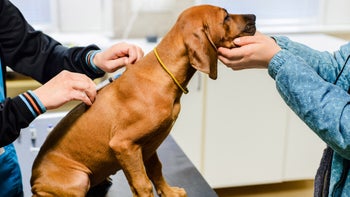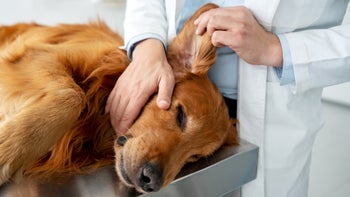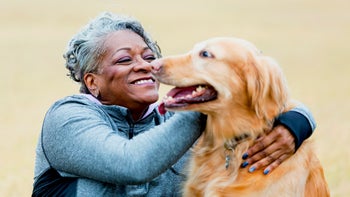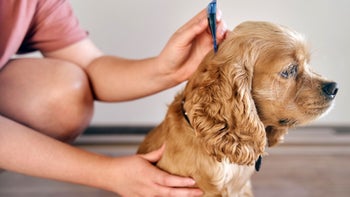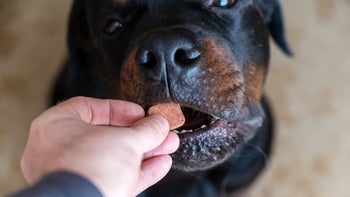
Canine Anal Gland Expression: How to Express a Dog’s Anal Glands
Key takeaways:
The first sign that a dog has issues with their anal glands is scooting or dragging their butt across the floor. You may also see them biting around their anal area or showing signs of pain.
You can manually express your dog’s anal glands at home, or your veterinarian can perform the procedure in their office.
How often your dog needs their anal glands expressed depends on your dog. Keeping an eye on your dog’s anal glands and expressing them when needed can help prevent health problems.
Table of contents
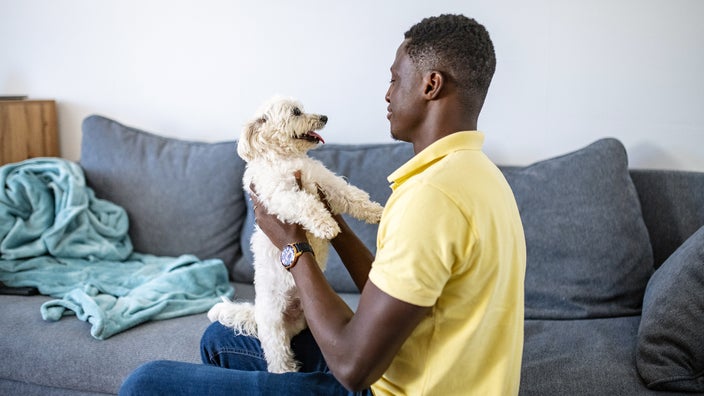
Your dog’s anal glands are not usually a conversation starter. But knowing how they work and how to recognize a problem can ultimately save your dog (and you) much discomfort. Plus, understanding how to express your dog’s anal glands can offer them immediate relief. Read on to learn more.
What are anal glands?
Anal glands are small sacs on either side of your dog’s anus. They secrete fluid originally meant for scent-marking in the wild. When your dog poops, fluid from their anal glands is also released. But some dogs may not release enough fluid naturally. In that case, the excess anal gland fluid may need to be removed by you or a veterinarian.
Many dog owners will never need to know how to express their dog’s anal glands. But if signs of anal gland issues occur, you should know how to recognize them and how best to treat them.
Save on the top 10 pet medications
Save big on common pet medications like Fluoxetine and Levetiracetam at your local pharmacy.

GoodRx is NOT insurance. GoodRx Health information and resources are reviewed by our editorial staff with medical and healthcare policy and pricing experience. See our editorial policy for more detail. We also provide access to services offered by GoodRx and our partners when we think these services might be useful to our visitors. We may receive compensation when a user decides to leverage these services, but making them available does not influence the medical content our editorial staff provides.
How do you manually express a dog’s anal glands?
If you decide to manually express your dog’s anal glands at home, it can be helpful to have a second person holding your dog. You can distract your dog with a chew toy stuffed with natural peanut butter or treats to occupy their attention.
Here is how to express your dog’s anal glands:
Place a large dog on the floor with a towel behind them. You can place a small dog on a table with a towel beneath them. Wear a pair of disposable latex or surgical gloves.
A dog’s anal glands are on either side of their anus. You should be able to feel the glands when they’re too full. Put some petroleum jelly on your thumb and forefinger and press your fingers against your dog’s anus.
Hold a paper towel or rag behind your dog’s anal area with one hand. With your other hand, gently squeeze their anal glands together with your thumb and index finger. A smelly, brown fluid will be released as you squeeze.
Squeeze both sides to express both glands fully. Praise and reward your dog throughout the process.
Once you have emptied both sides, use a washcloth and warm water to clean your dog’s anal area. Clean all fluid out of their surrounding fur to eliminate any odor.
Remove your gloves and dispose of them with the rags or paper towels, and place all towels in the wash.
If this sounds uncomfortable to you, your veterinarian's office or groomer can perform the procedure.
How to tell if your dog’s anal glands are full
When dogs need their anal glands expressed, the first sign is usually scooting their rear on the ground. You may also be able to see and feel that your dog’s glands are full. A full anal gland will feel puffy to the touch and be about the size of a grape.
Other signs that your dog needs their anal glands expressed include:
Having a foul, fishy odor
Licking or biting around their anal area
Chasing their tail
Showing a change in color of anal gland fluid from yellow or tan to a thick brownish-gray
Straining or having difficulty pooping
Having matted fur around their anus
Having swelling and redness around their anus
Household hazards: There are things around your house that are dangerous to dogs and can make them very sick. Here’s a list of the top 17.
Poop scoop: Do you know why your dog is pooping in the house? These 9 reasons are the most likely.
Tummy treatment: No dog owner wants to see their dog miserable with an upset stomach. Read about the remedies and medications that can help.
How often do dogs’ anal glands need to be expressed?
How frequently a dog needs their anal glands expressed depends on the dog. Many dogs never require the manual expression of their anal glands. Others will need their glands emptied every few weeks.
Some dogs’ glands (anal sacs) can become full, impacted, blocked, or infected. When a dog’s anal sacs become blocked, it is usually because of inflammation of the ducts. When this happens, the fluid within the sacs thickens, causing pain, swelling, and difficulty going to the bathroom. A dog with blocked anal sacs will need to be treated immediately.
When should you notify the vet about dog anal gland issues?
Contact your veterinarian as soon as possible if any fluid from your dog’s anal glands is thick, chunky, green, yellow, or white. This could be a symptom of infection, and your dog may need antibiotics.
Read more like this
Explore these related articles, suggested for readers like you.
If your dog continues scooting their butt across the floor for more than a few days after their glands have been emptied, consult your vet to see if there is another cause. Anything that can create itching — such as worms — may cause your dog to scoot their butt across the floor or ground.
What happens if a dog’s anal glands aren’t expressed?
If your dog cannot empty them naturally while going to the bathroom, their glands may become impacted. The fluid inside thickens, so the glands swell. Bacteria that usually leave the body when your dog poops will instead sit in the glands and become infected.
If this situation is not treated, abscesses can form. As an abscess grows, the anal sacs are filled with pus that blocks anal fluid from leaving the body. If not treated, an anal sac abscess can also rupture. An abscess is painful and messy and requires veterinarian treatment.
Common anal gland problems in dogs
Anal gland abscesses: A dog can develop a painful infection when pus builds up in the sac. This infection creates abscesses.
Ruptured anal gland abscesses: A ruptured abscess occurs when the pus buildup in the sac bursts. It’s painful to dogs.
Anal gland infection: A buildup of bacteria in the glands can become infected.
Anal gland impaction: Impaction is a form of anal gland disease that leads to hard masses in the sac area.
Worms: Dogs with worms often have itchy bottoms, but worms don’t cause anal gland problems.
What health issues can affect a dog’s anal glands?
Certain health issues can increase the chances of a dog developing impacted or infected anal glands.
Dogs are more likely to develop problems with their anal glands if they have:
Atopic dermatitis
Lack of fiber in their diet
Chronic soft stool or chronic diarrhea
Allergies (food or environmental)
How to prevent anal gland issues in dogs
There are a few things you can do to prevent anal gland issues in your dogs.
Express your dog’s anal glands at home regularly or have them expressed regularly by a groomer or veterinarian.
Feed your dog a high-fiber diet.
Help your dog maintain a healthy weight. Obesity can contribute to anal gland problems.
Treat your dog’s food allergies or atopic dermatitis. These conditions raise the risk of anal gland issues in dogs.
Frequently asked questions
While all types of dogs can develop impacted anal sacs, they are more common in smaller breeds and older dogs.
Research suggests that some breeds are at higher risk for developing anal sac disease. Those breeds include:
Cavalier King Charles spaniel
King Charles spaniel
Cocker spaniel
Shih tzu
Bichon frisé
Cocker spaniel and poodle mix
But there isn’t a lot of research published on the topic.
A dog’s anal glands are located on either side of their anus — the area on your dog’s rear where their poop comes out. They are internal glands, but you may be able to feel them when you press on either side of your dog’s anus, especially if their anal glands are full.
Maybe. Your veterinarian may recommend fiber supplements to help your dog’s anal gland issues. Fiber supplements can bulk up poop, which can help anal sacs empty when dogs do their business. Ask your veterinarian about fiber supplements if your dog’s anal glands clog regularly.
The bottom line
It is not entirely clear why some dogs need their anal glands expressed and others do not. However, if your dog shows signs of impacted anal glands, do not ignore them. Symptoms of packed anal glands include having a foul, fishy odor; licking around their anal area; and chasing their tail. Without treatment, full anal glands can lead to more serious issues, such as infections and abscesses.
If you are comfortable expressing your dog’s anal glands at home, follow the directions provided in this article and enlist help. You’ll need latex gloves, a towel, and some treats. However, do not put yourself in harm’s way. If you think your dog might bite or resist you, have a professional perform the procedure. Veterinarians and groomers can express your dog’s anal glands as needed. Your pup will thank you.
Why trust our experts?
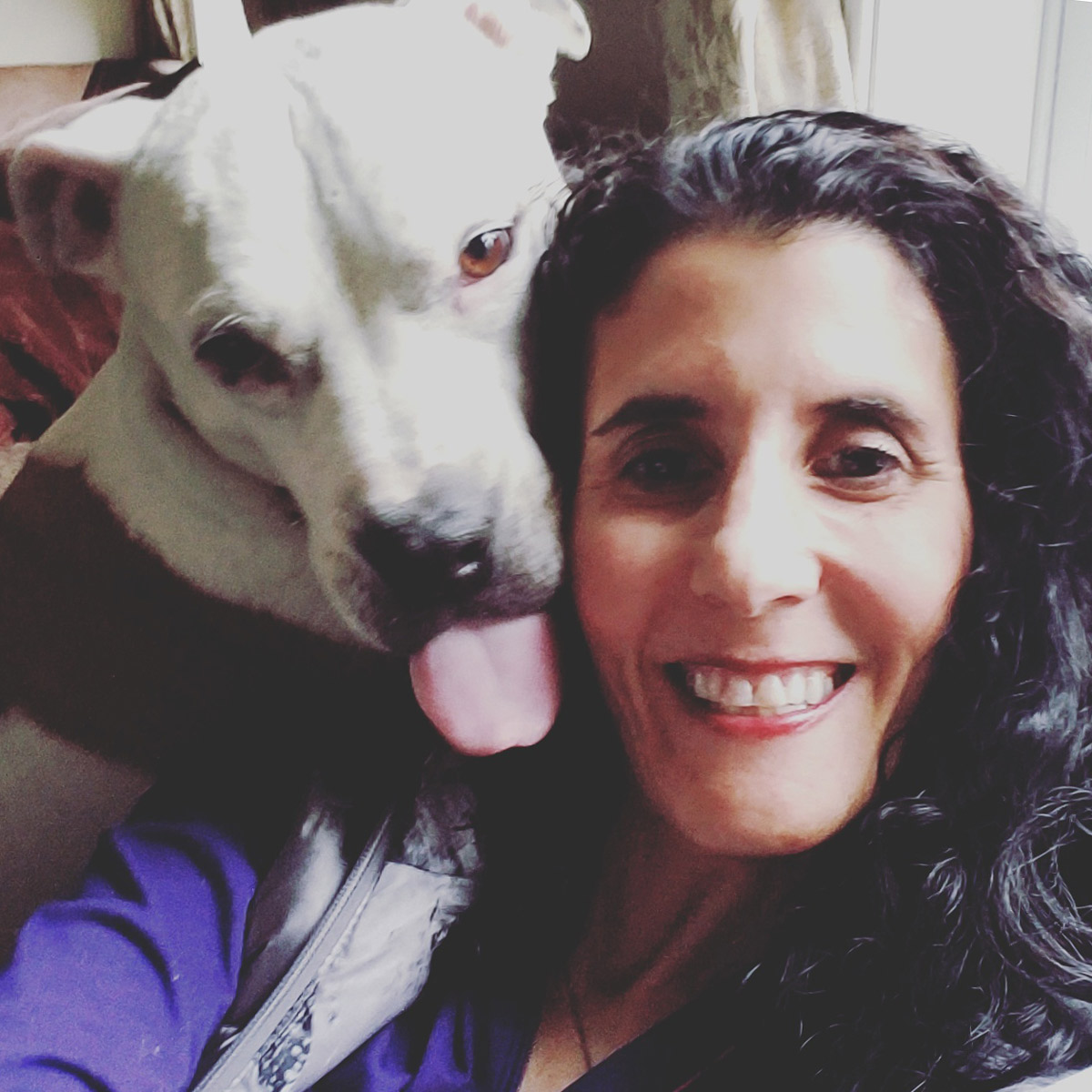


References
Brooks, W. (2023). Emptying a dog or cat’s anal sacs. Veterinary Partner.
Choi, L. (2018). A royal pain in the butt. VetzInsight.
Collins, B. (n.d.). Anal sac diseases. Cornell Richard P. Riney Canine Health Center
Corbee, R. J., et al. (2021). A cross-sectional study on canine and feline anal sac disease. Animals.
Gallagher, A. (2020). Anal sac disease in dogs and cats. Merck Veterinary Manual.
Lundberg, A., et al. (2022). Local treatment for canine anal sacculitis: A retrospective study of 33 dogs. Veterinary Dermatology.
O'Neill, D. G., et al. (2021). Non-neoplastic anal sac disorders in UK dogs: Epidemiology and management aspects of a research-neglected syndrome. Veterinary Record.
Radhakrishnan, S. (2024). Anal glands and anal gland abscess in dogs and cats. Veterinary Partner.
Rubin, S. I. (2018). Disorders of the rectum and anus in dogs. Merck Veterinary Manual.








